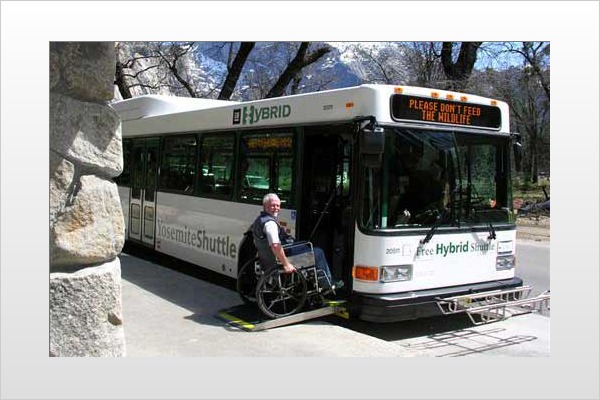
Yosemite National Valley is a magical place, not one where visitors want to be reminded of the city by breathing in clouds of exhaust and hearing the roar of a diesel engine. Realizing this, the National Park Service (NPS) replaced its aging fleet of diesel buses with a fleet of diesel-electric hybrid shuttle buses.
By switching to the 18 hybrid buses — making it the first all-hybrid fleet in the U.S. — the NPS estimates that particulate matter emissions have been cut by 90 percent (along with a 60-percent reduction in nitrogen oxide emissions), while fuel-efficiency has increased anywhere from 20 to 55 percent.
Hybrid technology was introduced into the passenger car market in 2000 when Honda began selling the space-age-looking, two-passenger Insight. Since then, hybrid technology has been increasingly used in different transportation applications, with the largest hybrid now capable of seating up to seven passengers. In passenger cars and trucks, a gasoline engine is paired with electric motors. The Yosemite buses, on the other hand, use a small diesel engine in place of the gas motor.
The sleek, modern shuttles, which are free to visitors at the park, have been cruising the roads that traverse Yosemite Valley since April 2005. They were built by the Gillig Corporation and equipped with General Motors' Allison's hybrid propulsion system. The hybrid powertrain isn't the only innovation on the buses; they also have comfortable air suspension systems (adjustable to provide a lower entry point for riders), panoramic light-sensitive windows and a GPS navigation system that lets passengers know exactly where they are. A regenerative braking system recaptures the energy normally wasted while braking or coasting on downhill stretches, and stores it in batteries for use by the electric motors at the next startup.
On a recent trip to Yosemite, one Edmunds.com editor decided to "test-ride" one of the new 40-foot buses. Even standing right next to the bus, there was never any diesel exhaust smell. It was also noticeably quieter thanks to the way the hybrid system is set up to rely mostly on electric power for starts and stops. This reduces diesel engine revving, which in turn reduces exhaust and noise pollution. The diesel engine is also smaller than it would be in a non-hybrid bus — in fact, it's similar in size to the diesels found in full-size pickup trucks.
Not only are the buses quieter to ride on, they're less intrusive to park visitors viewing the sights, riding on the bike paths or strolling along hiking trails near roads. Unlike city buses that growl and roar as they pull away from a stop, these buses accelerate with little additional noise. Another benefit to the shuttle fleet is that it cuts traffic inside the park. During his stay in the park, our editor and his family relied entirely on the hybrid buses rather than taking their personal car to different attractions and trailheads.
The 18 new shuttles were introduced to replace 12 diesel-only buses built between 1988 and 1996. The buses are operated by Delaware North Companies, which subcontracts its services to the National Park Service. The NPS estimates that the buses serve some 1,050 passengers per hour, 15 hours a day, year-round.
When visiting this crown jewel of the national parks system, one can't help but be more sensitive to the environment. In this way, the hybrid buses seem appropriate and allow passengers to enjoy the amazing scenery out the windows without a tinge of guilt.